USB Flash Drives - Power Consumption Measurement using Plugable's USBC-TKEY
by Ganesh T S on March 18, 2016 9:10 AM EST- Posted in
- Gadgets
- Flash Drive
- DAS
- USB-C
- Plugable
USBC-TKEY in Action
The power consumed by various USB flash drives was measured under multiple scenarios. These scenarios were triggered using CrystalDiskMark 5.1.2 x64 with a 8GB test file and each test separated by a 10s interval. Flash drives typically come under two broad categories - one with a native USB controller, and the other with a SATA drive talking to the host through a SATA - USB bridge. As an example of the former category, we put the Mushkin Atom 128GB version under the scanner. For the second category, we evaluated the Samsung Portable SSD T3 along with a host of other samples.
The initial part of the graphs below show the idle power consumption of the drive. This is followed by the power consumed when CrystalDiskMark prepares the 8GB test file on the drive. The eight distinct segments that follow show the power consumption profile for the workloads (single-threaded sequential and random accesses with a queue depth of 32, followed by sequential and random accesses with a queue depth of 1). The first four segments correspond to read accesses and the last four to write accesses.
Native USB flash controllers are very power efficient, but, that obviously comes at the cost of performance (numbers that can be seen in the review of the drive). We see that the Mushkin Atom 128GB version idles at around 170 mW and has a peak power consumption of only 1.22 W. On the other hand, using a mSATA SSD and adding a SATA-USB bridge is quite punishing. For the Samsung Portable SSD T3, the idle number moves up to around 290 mW, while the peak is around 3.34 W.
The graphs below compare the power consumption of various drives we tested under different scenarios. The Mushkin Ventura Ultra 120GB (based on a SandForce SF2281 SSD connected through a USB 3.0 - SATA bridge) is the worst when it comes to power consumption (flash drives based on SF2281 are notorious for overheating and throttling). As expected, getting rid of the bridge and going native helps the Mushkin Atom 128GB to be the most power efficient in the tested lot.
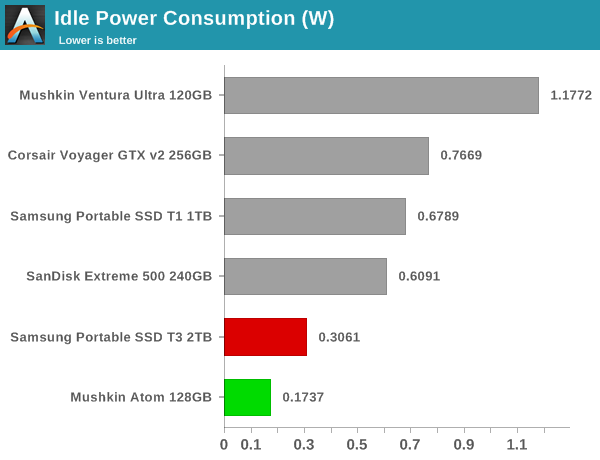
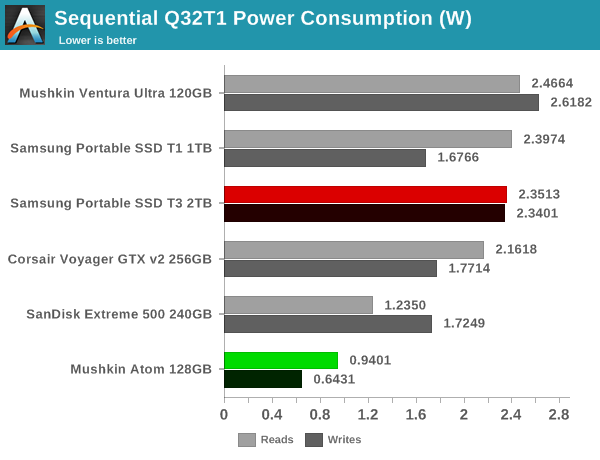
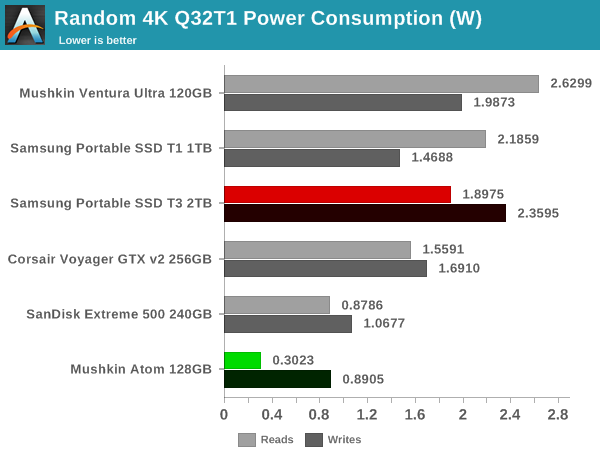
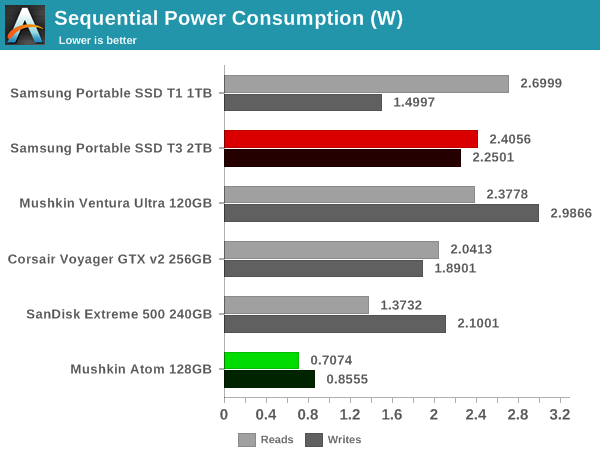
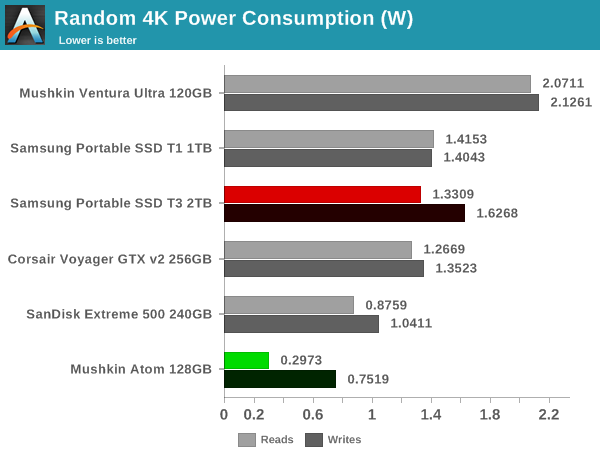
Concluding Remarks
The Chromium Twinkie / Plugable USBC-TKEY is an invaluable tool for device developers looking to debug their USB Type-C hardware. As we showed in this article, it also enables us to gain key insight into the power consumption profile of USB peripherals. We tested out various USB flash drives, and that yielded interesting, albeit, expected results.
All our tests used either USB 3.0 Type-A (with a Type-A to Type-C USB 3.1 adapter cable) or USB 3.1 Gen 1 Type-C devices. Since the USBC-TKEY is designed to be transparent to the host and device, and is fully compatible with USB 3.1 specifications, we don't expect any issues with measuring power consumed by USB 3.1 Gen 2 or Thunderbolt 3 peripherals (since Thunderbolt 3 also utilizes USB power delivery). The Plugable USBC-TKEY will enable us to add yet another evaluation point to our comprehensive direct-attached storage testing process.


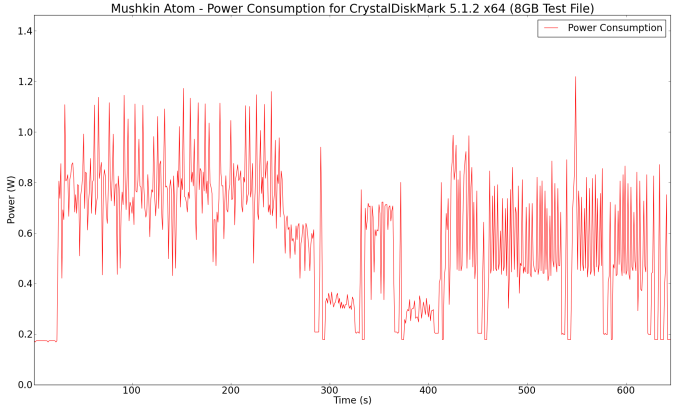
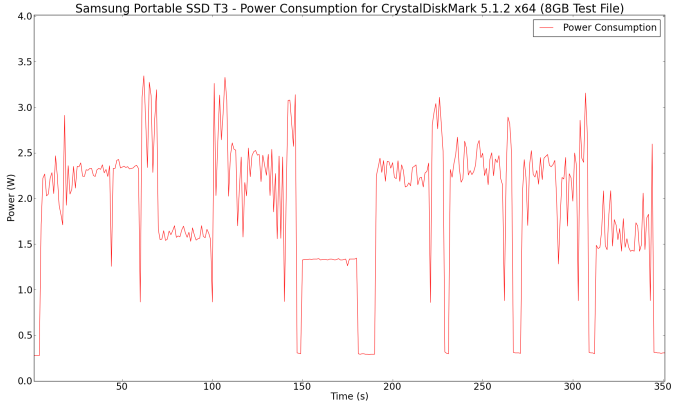








20 Comments
View All Comments
InterClaw - Friday, March 18, 2016 - link
How about a graph comparing total power consumption for a specific task, like "rush to idle".icrf - Friday, March 18, 2016 - link
What is the closest model for a streaming use case? Sequential QD=1 sounds close, but if streaming videos stored on a USB drive on a tablet/phone, you're not running at peak throughput even at QD=1. That's also the kind of case where power consumption and battery life matter a lot.I don't know if that's the kind of task you were referring to with "rush to idle".
InterClaw - Friday, March 18, 2016 - link
I mean like performance per watt, so even if a drive consumes more power doing a certain task it maybe finishes a lot quicker and the total amount of power consumed could actually be less. Perhaps figures like this could be interesting to include in the future.ISGoodwin - Friday, March 18, 2016 - link
While maximum power draw for certain tasks, it would be helpful to be able to see a normalized figure to be able to compare efficiency. It may even be necessary to have a test that has a specific set of usual tasks, heavy, medium and light like you do with the SSD reviews to see how the characteristics change depending on load.jabber - Friday, March 18, 2016 - link
Have to say power consumption is the last concern I have re. USB sticks. Some folks have far too much time on their hands.name99 - Friday, March 18, 2016 - link
You (and plenty of the commenters above) are being exceptionally ignorant, and didn't read the article properly where this is all explained.There is a HARD CAP on the power draw available to a USB2 port of 2.5 W. There is a HARD CAP available to a USB3 port of 4.5W.
This means that if you take one of the drives in the list that exceeds 2.5W under some conditions. it will (more or less randomly) work then fail when connected to a standard USB2 port --- essentially it will exhibit random (and thus very hard to debug) failure, especially since it will always mount without a problem. Even if you're connecting it to USB, if you're connecting to a hub you may have the exact same problem --- the drive always appears to mount, then sporadically fails when a sequence of random reads or writes exceeds the current available (given that some other device on the hub is also using power).
THAT is why the important number for these devices is the worst-case peak number, not an average or the total power consumption or anything like that.
ISGoodwin - Friday, March 18, 2016 - link
While you have a valid point about non type C connectors, it was not the only one in the article as the implication I read was how the power of a storage stick can adversely affect the life of a portable device which would make efficiency a major factor. No-one has mentioned removing the above information, only adding to it, which can only help.InterClaw - Friday, March 18, 2016 - link
Ideally, the drive should enter a low performance mode under those circumstances so as to not encounter failures. But perhaps that's wishful thinking.krutou - Saturday, March 19, 2016 - link
Based on name99 and dano_spumoni's comments, this article should have been named and focued on "Peak Power Consumption Measurement..."I've had similar connection issues when running a portable SSD via front panel USB.
Murloc - Sunday, March 20, 2016 - link
just because you're not connecting external HDs to your phone